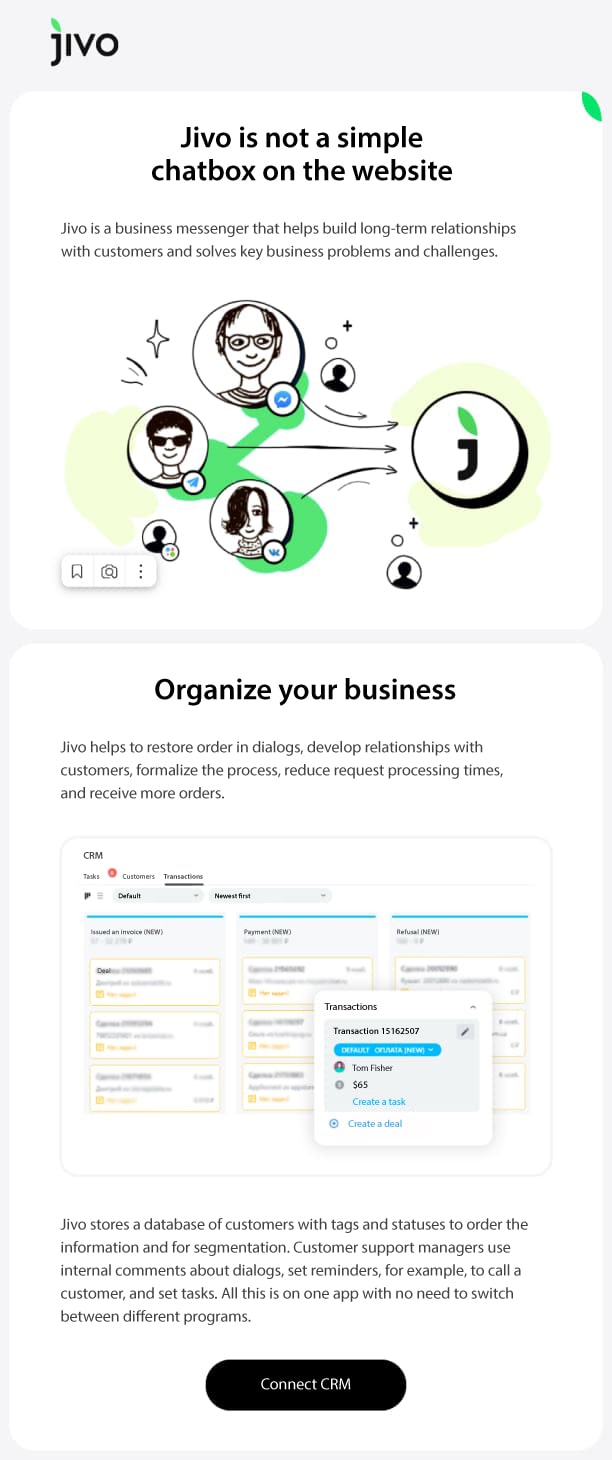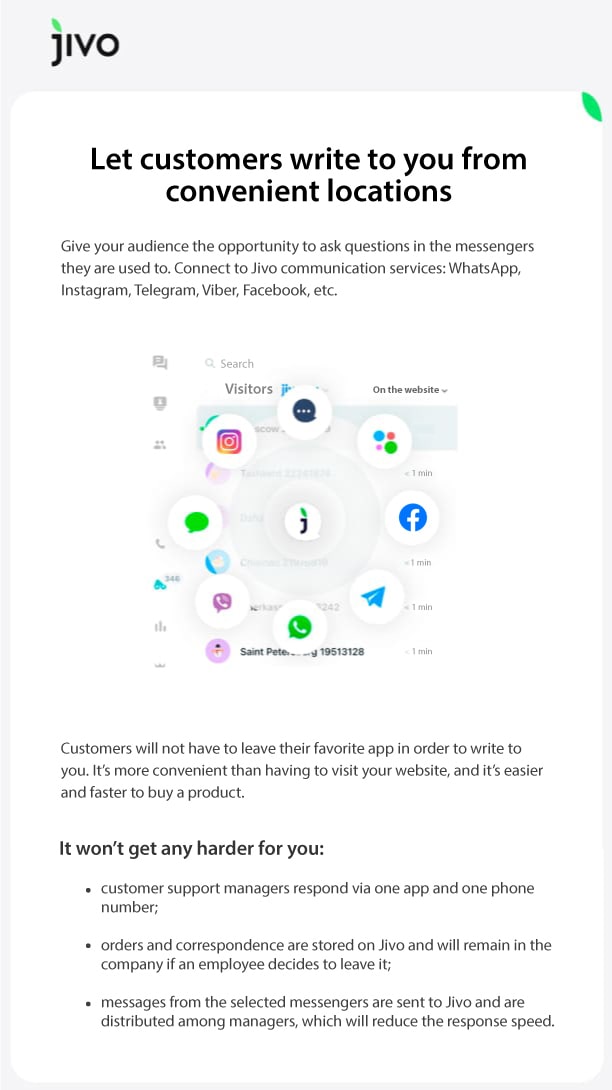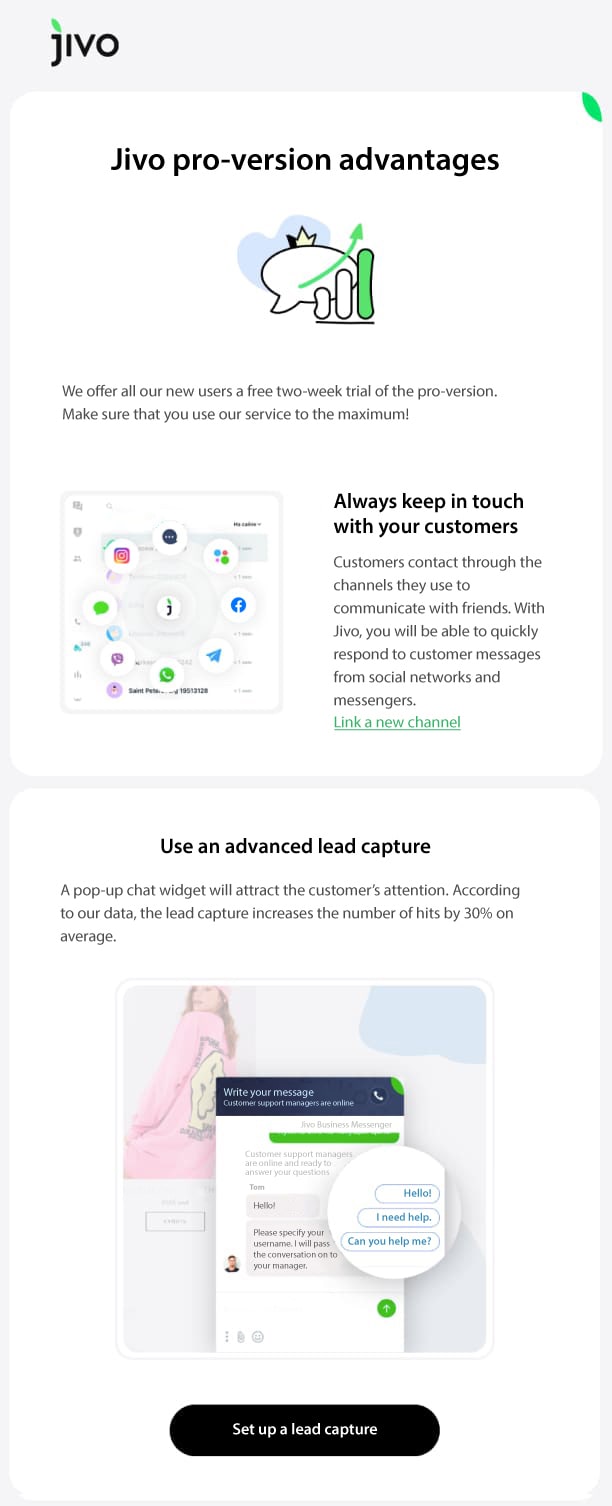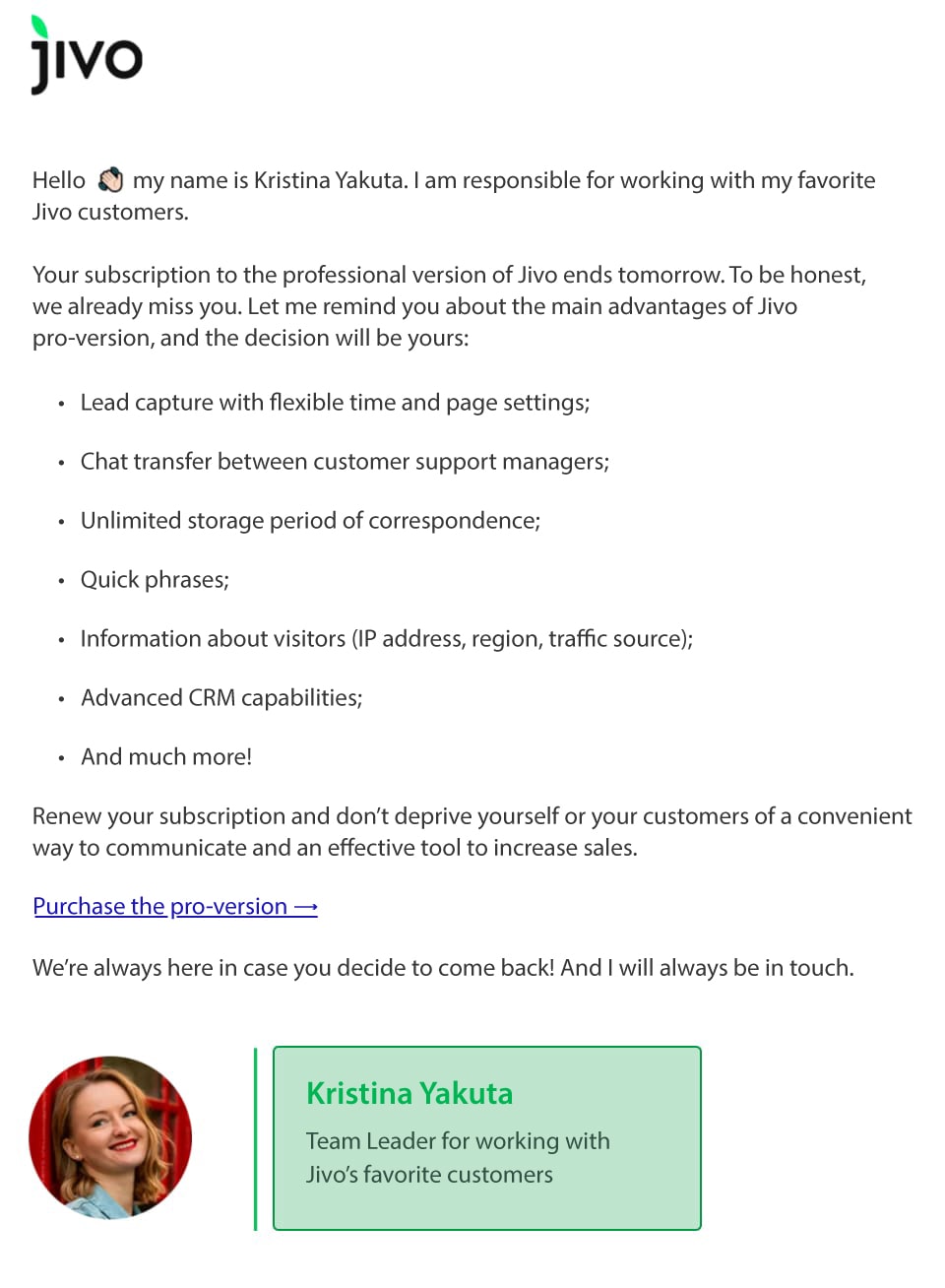In 2020, Jivo automated its marketing using Maestra. The team can now build complex client segments and create reports without the help of an analyst. Conversions of their welcome sequence have increased drastically as well.
How Jivo Increased Conversions by 35.5% In Its Welcome Email Series
Goals
Increase the number of customers who use the paid version of Jivo
Speed up the launch of emails, pop-ups and hypothesis testing
Speed up the launch of emails, pop-ups and hypothesis testing
Solutions
Change the current mailing service to speed up launches
Launch emails for the main stages of the customer’s life cycle
Launch emails for the main stages of the customer’s life cycle
Results
35.5% increase in welcome chain conversions to purchases of the paid version of Jivo
Launching bulk emails now takes less time — what used to take 3 hours now takes 15 minutes
Launching bulk emails now takes less time — what used to take 3 hours now takes 15 minutes
IT stack.
Self-made website, desktop and mobile apps, marketing automation platform
The following case study is from Mindbox, the original brand behind Maestra’s technology
In 2020, Jivo underwent drastic changes: the marketing department grew (a CRM marketer and content specialists joined the team of advertising specialists) and the team decided to automate their marketing using Mindbox. The platform replaced the existing service, as it was unable to solve the team’s CRM-marketing challenges. For example, this service didn’t allow in-depth customer segmentation and it couldn’t quickly build reports on campaigns without the help of analysts. Read Jivo’s story to learn:
- How to take into account the requirements of the marketing and technical departments when choosing a platform — you’ll find a section detailing all of Jivo’s requirements below.
- How you can speed up the launch of bulk email campaigns and pop-ups, as well as how to speed up reporting.
- How to increase conversions to paying users by 35,5% in welcome emails.
- Which hypotheses of the sales department can be tested with the help of A/B tests in emails.
In 2020, the marketing department faced challenges that required we change our approach to customer communications. We needed to reduce the time spent on implementing new mechanics, to find new channels of interaction with customers, and to make marketing more flexible and targeted. At the time, it was impossible to implement the existing ideas without modifications, and each of the tasks required a separate service. We realized that the solution had to be universal. This would be a kind of common operating space, within which we could accumulate data and manage communications from a single window.
The Mindbox platform became the solution for us. We used to involve developers to test new communication channels. It was also virtually impossible to analyze the effectiveness without the help of analysts. Now, this is all achieved within the marketing department without the need to involve third-party resources.
Results. We don’t lose out on efficiency and credibility, while at the same time we’ve gained a lot in both time and money. The process of implementing complex new solutions has become easier and faster, with the ability to test more hypotheses, which ultimately leads to an improvement in business performance. For us, this is exactly the result we were aiming for.
Marketing Automation Results
-
+35.5
% increase of the welcome chain’s conversion rate compared to the control group -
3
h → 15min
-
2
weeks → 2h the current launch time of pop-ups on the website -
2
days → 5min the time it now takes to build a customer segment
The results of the welcome email sequence amazed us. We expected an increase of around 11%, but we got an incredible 35.5% instead!
Results overview. I now create and run email campaigns and pop-ups on the website faster. I also set up filters and create segments much quicker. As a result, I don’t need to get in touch with the analyst as often. The platform helps to test hypotheses faster and easier than the previous mailing service.
One of the platform’s advantages is the opportunity to launch emails and pop-ups and monitor analytics on these using the same window. We track the behavior of the blog and website audiences, the overlap of audiences, and the interaction of each segment with our communication channels separately. I used to have to go to an analyst for this, and it took several days. Now I do everything myself on the platform and only need to spend a few minutes on it.
Challenges related to the results. We cannot determine exactly how much money the email channel brings in, for two reasons:
— license payment data is stored in the CRM system and is not transmitted to the platform;
— several channels are involved in the sale. For example, the customer was redirected from the email to the website, then visited the “Subscription” section, contacted a manager for an invoice, then there was a pause of several days until the customer made a payment. In our billing system, this sale is attributed to the sales department, not the email segment.
Therefore, our main mission is to test the hypotheses using A/B tests. This helps to evaluate communications, to understand whether or not the launch of the email resulted in an increase, and whether or not it affected sales relative to the control group.
How Jivo Chose the Platform
The IT department and the marketing department put together a list of features that were needed on the platform. We talked to several vendors. In addition to this list, we discussed:
— The ease of integration. It was important for us to be able to easily transfer data to a new platform. This would ensure that the transition would not take up a lot of resources.
— ROI. We planned the marketing strategy for the next few months, taking into account which campaigns we would launch, which modules we would connect (for example, pop-ups), and calculated how long it would take for the platform to break even. There were two predicted scenarios: one pessimistic and the other optimistic. This helped us defend our decision to change platforms to our CEO and CTO.
A fragment from the list of features that Jivo was looking for in a platform:
Integration
Working with data
Segmentation
Communication channels
Advertising systems
Personalization (website, campaigns)
Testing and reports
Integration and data transfer
Cleansing and unification of email addresses
Setting up segments
Email, in-app, mobile and webpush, pop-ups, Whatsapp, Telegram
Automatic uploading of audiences to Facebook, Google Ads
The ability to use pop-ups
Ability to run A/B tests in all channels
Collect and merge data about the user from different external systems
Cross-channel identification
A set of data for segmentation (for example, personal data, behavior in different channels)
Setting up trigger communications in one channel and cascades, prioritization, limiting the frequency and number of triggers
Availability of ready-made integrations
Dynamic content
Tests with a control group
Using customized fields
Integration monitoring
Ability to save any segment and change its settings
Launch triggers for any events (changing data, switching to another segment)
The possibility of using the PPC-campaign as a step in the communication chain
Prediction of profitability in an unauthorized session
Uploading data with the results of single and multiple campaigns
Support multiple identifiers
Verifying user identity
Real-time segment recalculation
Visual designer for branching settings and conditions for a trigger campaign
Can we transfer data and what kind of data do we need to personalize ads in the PPC system?
The ability to analyze and choose the best sending time
Ability to trace the behavior of a particular segment in emails
Ability to store session data
Automatic gender detection by name
Creating static and dynamic segments
The possibility of testing: A/B tests and tests using a control group
Data transfer to PPC systems to build a look-alike
Choosing the preferred communication channel for each user and prioritizing it
Tracking the growth of the customer base
Store bundles between users
See all the changes for a specific user in one place
Churn prediction
Automation of UTM markup
Transfer of data on actions in messages to PPC-systems
Building reports with campaign results for each channel
Tools for working with the referral program
RFM segmentation
Exporting data to external analytics systems
Main Features
Objectives
Marketing objectives
Complex customer segmentation
The marketer will be able to configure narrow audience segments independently, without the help of the IT department. For example, segments based on language, number of operators, chat activity, connected tools (Telegram, chatbots, CRM), and the expiration date of the paid tariff.
Campaign analytics
A marketer will be able to create reports on campaigns with different target actions independently, without the help of an analyst — for example, subscription to a paid tariff or connecting a new channel (Telegram, AliExpress).
Working through webhooks
Webhooks are intended to send in-app mailings on the Jivo personal account. A marketer will be able to create a customer segment and send in-app mailings via webhooks about activation, renewal of the paid version, or about promotions. All this can be done via the platform.
Compliance with legislation
The collection and storage of audience data must fully comply with the requirements of current data protection legislation.
How Marketing Has Changed after Automation
Jivo uses the following IT systems for marketing tasks: a CRM system that stores data on payments, a mailing service for customers around the globe, and the Mindbox platform for customers from the CIS.
Before automation was introduced
After automation was introduced
Communication strategy
No unified communication strategy. There were several trigger and bulk emails. These were sent haphazardly — e.g., on days when the product department and the sales department simply decided to make announcements to customers.
A strategy for communicating with the audience emerged. This is a logical sequence of emails for all stages of the customer life cycle:
• onboarding emails for all products (for newcomers);
• emails about upgrading to the paid version, subscription renewal reminders, notifications about new products and promotions (for existing customers);
• reactivation emails (for churned customers).
• onboarding emails for all products (for newcomers);
• emails about upgrading to the paid version, subscription renewal reminders, notifications about new products and promotions (for existing customers);
• reactivation emails (for churned customers).
Campaign analytics
To better understand the effectiveness of emails, the team had to ask an analyst for help. The analyst exported reports for each campaign, taking into account the different target actions (purchase of the paid version, connection of a new channel), which were summarized manually.
It takes the CRM marketer a few minutes to upload reports on each campaign, without having to involve an analyst. Reports are generated automatically.
Launching bulk emails
3 hours (if the email copy is ready).
Each stage of the email launch (segment creation, letter setup) took place on separate pages, making it impossible to see all the settings on one screen and check for errors.
Each stage of the email launch (segment creation, letter setup) took place on separate pages, making it impossible to see all the settings on one screen and check for errors.
15 minutes (if the email copy is ready).
The launch time has been reduced as the launch is now configured on a single page in the platform.
The launch time has been reduced as the launch is now configured on a single page in the platform.
Launching pop-ups
2 weeks.
Developers with limited resources were involved in the launch.
Developers with limited resources were involved in the launch.
2 hours.
A CRM marketer launches pop-ups without developers.
A CRM marketer launches pop-ups without developers.
Audience segmentation
2 days.
The team brought in an analyst to build segments in the analytics system for specific filters, to unload these segments, and then upload them to the mailing service.
The team brought in an analyst to build segments in the analytics system for specific filters, to unload these segments, and then upload them to the mailing service.
5 minutes.
The CRM manager independently creates a segment in the platform without the help of an analyst.
The CRM manager independently creates a segment in the platform without the help of an analyst.
Jivo’s Target Email Audiences
Jivo has five audience groups. We established email communication with three of them using automatic trigger emails (for example, a standard welcome series) and bulk emails (digests, emails about product updates, promotions).
Audience
Communication features
Microbusinesses, small businesses, and customers who use the free version of Jivo (any scale of business, sometimes those who use chat for a personal website)
Such companies often have limited resources. For example, there is no dedicated specialist to communicate with customers on the website and on social networks, or one specialist has a heavy workload and does not have enough time to deal with Jivo.
The marketing department communicates with them, explaining in emails how to use Jivo and what the benefits of the paid version are.
The marketing department communicates with them, explaining in emails how to use Jivo and what the benefits of the paid version are.
Medium-sized businesses
The customer connects to Jivo for a 14-day free trial period. Once the free trial period ends, the sales manager calls the customer to discuss their experience, to talk about Jivo products, to assist in selecting the right ones, and to discuss pay-per-connection. Emails are also sent to help the manager complete the transaction.
Large-scale businesses
Sales managers are engaged in communication with large companies at all stages (first contact, connection, subscription renewal).
Examples of emails:

Bulk digest helps users learn about Jivo product updates.
Increasing Sales with the Welcome Email Series
The welcome sequence was launched after the specialists from marketing, product, and sales departments analyzed customer behavior and discovered a bottleneck in the sales funnel — the first two weeks of using Jivo (the trial period). Next, Jivo did the following:
- The team analyzed customers' behavior in depth in their first two weeks. It turned out that customers only used the chat function and were unaware of other products. For example, a customer uses Jivo chat on the website and communicates directly on WhatsApp and Telegram, getting lost in hundreds of messages. Although Jivo has chats for these messengers and other products for business — for example, chats on social networks.
- Communications were analyzed and the team found that after registration, customers do not have the opportunity to go through onboarding. They simply have nowhere to find out about Jivo products and the benefits of the paid version.
- A survey on the website asked customers what products they use and whether they know about additional Jivo functions — for example, the CRM system. The survey showed that many customers did not know about this.
- The team built an analytical model to predict at which stage of the customer lifecycle communications can provide the maximum amount of growth. The following factors were taken into account: the customer’s journey from registration on Jivo to repeated payments, advertising costs, the average purchase valye, churn, and LTV, and how they affect total revenue.
This model helped determine that working with customers in their first two weeks with Jivo could bring an 11% increase. - Jivo launched an onboarding welcome sequence and tested it:
- Hypothesis. The conversion rate to purchases of the paid version will increase by 11% if customers learn about Jivo’s products and capabilities in the welcome series.
- Test. Half of the audience receives a welcome email sequence, half does not.
- Result. The conversion rate increased by 35.5% compared to the audience that did not receive the welcome emails. The reliability of the result is 99.2%
Data from Jivo’s internal reporting, Last Click Attribution
Previously, we didn’t have any emails at all that fully uncovered Jivo’s benefits and features for customers. This welcome series demonstrated excellent results: the conversion of customers who bought the paid version increased by 35.5%.
In fact, thanks to this one A/B test with the welcome sequence, we were able to break even after six months of using Mindbox.
Welcome sequence emails:



Types of A/B Tests and How Hypotheses Are Tested
The marketing department made hypothesis testing a standard procedure. For example, after testing the hypothesis of the welcome sequence we conducted another test:
- Hypothesis. The conversion will increase if, after the end of the trial period, customers are sent a series of emails that focus on missed opportunities as a result of transitioning to the free version.
- Test. Half of the audience received the email series, half did not.
- Result. There are no significant differences. The reliability of the result is 90%. We therefore decided to work on this email series a bit more.
Data from Jivo and Mindbox’s internal reporting, Last Click Attribution
When it comes to communications, hypothesis testing has moved beyond the marketing department. For example, together with the sales department, we conducted the following test:
- Hypothesis. The number of sales of Jivo’s paid version will increase if a personal signature is added to the subscription renewal emails — i.e., the name of a specific manager or sales manager.
- Test. Half of the audience received emails with a personal signature, half received emails sent on behalf of Jivo.
- Result. There were no significant differences between the two versions of the chain. The reliability of the result is 90%. However, the test helped improve the sequence overall.
- We found that the open rate for the first email with a personal signature was higher than for the first email without a signature: 30.73% vs. 20.67%.
- The conversion of the last email without a signature is 14% higher than in an email with the manager’s signature.
- Therefore, we formulated a new hypothesis. If we combine two variants of emails (one with a personal signature and another with a signature on behalf of Jivo), key metrics such as open, click and conversion rates will all increase. Jivo is currently testing this hypothesis.
Mindbox data, Last Click Attribution

Renewal of paid subscription email with a manager’s signature
Plans for Improving and Developing Direct Marketing:
- Set up analytics to evaluate the effectiveness of the email channel. To do this, transfer Jivo payment data from the CRM system to Mindbox and implement end-to-end analytics.
- Introduce new communication channels, such as mobile push notifications, in order to send messages in channels that are more convenient for customers
P. S. In this story, we talked about our Customer Data Platform (CDP), Website personalization modules. Find out more about these products by following the links to their pages or by talking to one of our consultants.

